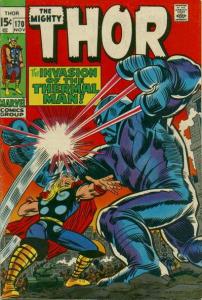The month of November, 1970 brought comics readers the third installment of writer-artist Jack Kirby’s run on Superman’s Pal, Jimmy Olsen — a book which also happened to be the third installment of the massive, multi-title, interconnected epic that we’d eventually come to know as Jack Kirby’s Fourth World, though few if any of us who were reading the comics as they came out fifty years ago had more than the vaguest inkling of that fact.
But it hardly mattered, because Kirby was giving us so much to thrill to and wonder at in each issue of Jimmy Olsen on its own, with no need for reference to any larger narrative. The “King” had come roaring out of the gate with his very first issue, #133, which set Jimmy and his new best friends, the Newsboy 
 Legion, on a mission into the mysterious Wild Area, where they immediately got mixed up with a community of motorcyclists called the Outsiders, who made their home in a “tree city” called Habitat. The next issue, #134, found Jimmy and company taking their super-vehicle, the Whiz Wagon, out onto a subterranean drag strip called the Zoomway, joining the Outsiders in a quest for the Mountain of Judgement — which turned out to be an enormous, high-tech mobile home, the headquarters of yet another hidden society, the Hairies. In the issue’s climax, a bomb that had been surreptitiously placed in the Whiz Wagon was discovered and — with the help of Superman, who’d followed Jimmy and his colleagues to the Wild Area — dealt with just in time to prevent the Mountain of Judgement and its inhabitants from being blown to bits. The issue ended with Jimmy’s new boss, Morgan Edge — the man who’d built the Whiz Wagon for the Newsboys in the first place, and then sent them and Jimmy into the Wild Area — reporting in to his own, secret boss: a forbidding-looking fellow named Darkseid.
Legion, on a mission into the mysterious Wild Area, where they immediately got mixed up with a community of motorcyclists called the Outsiders, who made their home in a “tree city” called Habitat. The next issue, #134, found Jimmy and company taking their super-vehicle, the Whiz Wagon, out onto a subterranean drag strip called the Zoomway, joining the Outsiders in a quest for the Mountain of Judgement — which turned out to be an enormous, high-tech mobile home, the headquarters of yet another hidden society, the Hairies. In the issue’s climax, a bomb that had been surreptitiously placed in the Whiz Wagon was discovered and — with the help of Superman, who’d followed Jimmy and his colleagues to the Wild Area — dealt with just in time to prevent the Mountain of Judgement and its inhabitants from being blown to bits. The issue ended with Jimmy’s new boss, Morgan Edge — the man who’d built the Whiz Wagon for the Newsboys in the first place, and then sent them and Jimmy into the Wild Area — reporting in to his own, secret boss: a forbidding-looking fellow named Darkseid.
Quite a lot to take in for just two issues, wouldn’t you say? Read More

 Seven months ago, I blogged about a number of comics that I wish I’d bought back in April, 1970, the only month in the last 55 years in which I didn’t acquire a single new comic book. (At least not until April, 2020, when COVID-19’s temporary shutdown of the comics industry took the matter out of my, and everyone else’s, hands for a while.) Regular readers of this blog with good memories may recall that among those “comics that got away” was the 400th issue of Detective Comics.
Seven months ago, I blogged about a number of comics that I wish I’d bought back in April, 1970, the only month in the last 55 years in which I didn’t acquire a single new comic book. (At least not until April, 2020, when COVID-19’s temporary shutdown of the comics industry took the matter out of my, and everyone else’s, hands for a while.) Regular readers of this blog with good memories may recall that among those “comics that got away” was the 400th issue of Detective Comics.














